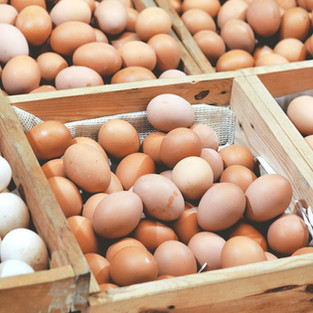Are all of the eggs in your basket the same?
- Molly Gallant

- Mar 11, 2019
- 4 min read
Updated: Aug 12, 2019
The infamous egg has been through it all with us – the ups, the downs and the altogether scrambled. The rollercoaster ride of contradictory dietary recommendations experienced by the egg is not at all unique in the world of food. As nutritional scientists continue to study and evaluate the health consequences of certain foods, we learn new information every day and the food industry adapts accordingly.
However, the humble egg is perhaps one of the few foods that after a prolonged period of scrutiny and criticism, has managed a full comeback.
Egg sales have been steadily increasing in Canada over the past 11 years. Most recent data from Agriculture and Agri-food Canada suggests that in 2017, Canada produced poultry and egg products worth $4.4 billion. They have calculated a per capita consumption of 20.2 dozen eggs (242 eggs per Canadian).
That seems significant, especially for a food that was once vilified for its high dietary cholesterol content. So, why have we seen such an impressive increase in sales? There are likely several factors at play here.
Since eggs’ villain status was officially revoked in 2015, they elevated to an almost superfood status. Eggs are recognized as a healthful source of protein and a range of nutrients including vitamins A, D and E, folate, iron, zinc and choline. Although consumer attitudes towards eggs began improving even before the 2015 announcement, consumption patterns continue to show an upward trend.
Beyond changing health information, there are likely broader food trends at play here. In this case, we must bring up the increasingly popular consumer trend towards flexitarian diets. As consumers shift away from meat as their primary protein source, eggs have become a satisfying – not to mention budget-friendly – protein source.
Another common theory pertains to the changes we see in popular breakfast foods. Canadians are now substituting cold cereal for heartier choices, like breakfast sandwiches, to start their day. Seen as a filling and convenient option purchased alongside a morning coffee, fast-food restaurants have been quick to embrace this trend. As a result, more and more fast-food restaurants are now offering all-day breakfast options. McDonald’s began offering all-day breakfast in February 2017 and immediately saw the effects. In the first 12 months, egg sales jumped 25%, translating to roughly 35 million more eggs purchased and eaten in Canada.
Egg Production Methods
Although the health debate on eggs has now been somewhat resolved, it seems public scrutiny has merely shifted away from nutrition, to the animal welfare implications of egg production. As a result, consumers now face a whole different set of decisions in the egg section of grocery stores.

Brown eggs or white? Free-run or free-range? Conventional or organic? Small, medium, large, jumbo? What do these terms mean and do they change the taste and/or nutrition of the eggs?
“What is the best egg to feed myself and my family?” – has become a difficult question for consumers to answer.
In short, it is with good reason. There doesn’t seem to be a "one size fits all” answer and the best choice for your family will depend on your personal preferences. No matter the kind of egg you choose, the nutrition facts will be similar, if not perfectly identical. Given nutrition and taste are comparable across egg varieties, the question of animal welfare has more so become centre of mind when selecting eggs.
This is where farmers saw an opportunity to innovate and expand their production practices in order to address consumer concern.
For consumers with animal welfare concerns, cage sizes grew, and nesting areas were made to more closely mimic chickens’ natural environment. For those with organic preferences, pesticide-free chicken feed was introduced to the market. As farmers began implementing these new practices, marketers set to work communicating their many options to consumers.
However, if you’re anything like me and are often left scratching your head in the egg aisle, it can be helpful to understand what you’re actually looking at.
Standard Eggs
Standard eggs make up 90% of the eggs available in Canada. Hens are kept in “battery cages” that are crowded at only 432 cm squared per bird – too little space to allow them to exhibit their natural behaviour. Birds have no access to nests, perches or scratching areas. However, animal welfare concerns have led to the decision to phase out battery cages in Canada by 2036.
Free-run Eggs
Hens raised as free-run are allowed free movement in an open barn where they have access to nests, perches and scratching areas. Birds are allowed more room, with 929 cm squared per bird.
Free-range Eggs
Free-range birds are raised almost identically to free-run – with the exception that they are allowed seasonal access to the outdoors.
Organic Eggs
Organic egg production practices are very similar to free-range with more room per bird and access to the outdoors. The main difference lies in the kind of feed used. All grains are required to be pesticide-free for at least three years. Additionally, hens are not given any antibiotics or growth promoting hormones. It is important to note here that no laying hens receive hormones in Canada – so if that’s your primary concern then any eggs will fit the bill.
Omega-3 Eggs
Finally, we have omega-3 eggs produced from hens being fed a diet high in flaxseed. As chickens are better at converting ALA to DHA, an essential omega-3 fatty acid, these eggs provide a source of important fatty acids often found in fish.
Now the final question to consider is perhaps more easily answered: how do you like your eggs?
Recommended citation format: Gallant, M. “Are all of the eggs in your basket the same?”. Food Focus Guelph (14), Department of Food, Agricultural and Resource Economics, University of Guelph, March 11th, 2019.
















Comentarios